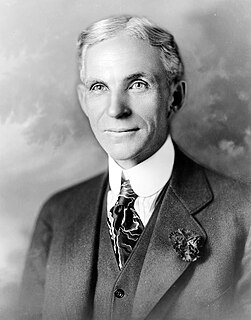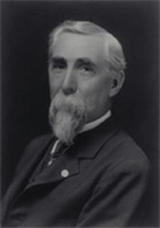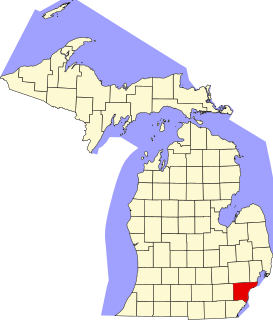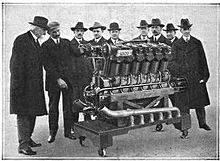
Henry Ford was an American industrialist, business magnate, founder of the Ford Motor Company, and chief developer of the assembly line technique of mass production. By creating the first automobile that middle-class Americans could afford, he converted the automobile from an expensive luxury into an accessible conveyance that profoundly impacted the landscape of the 20th century.

Lincoln Motor Company, or simply Lincoln, is the luxury vehicle division of American automobile manufacturer Ford. Marketed among the top luxury vehicle brands in the United States, Lincoln was positioned closely against its General Motors counterpart Cadillac. The division helped to establish the personal luxury car segment with the 1940 Lincoln Continental.

The Henry Ford Company was an automobile manufacturer active from 1901 to 1902. Named for Henry Ford, it was his second company after the Detroit Automobile Company, which had been founded in 1899. The Henry Ford Company was founded November 1901 from the reorganization of the Detroit Automobile Company. The company, much like the Detroit Automobile Company, was plagued by disputes between Ford and his investors, and Ford left in 1902. Later that year, the company was reorganized as the Cadillac Automobile Company under the suggestion of Henry M. Leland. Cadillac, whose early vehicles were identical in design to those of Ford's later Ford Motor Company except for the engine, would develop a reputation for precision engineering and was acquired by the nascent General Motors (GM) in 1909, becoming GM's luxury marque. Ford would eventually find success with the Ford Motor Company, and is considered one of the primary pioneers of the automobile.

Albert Kahn was an American industrial architect. He was accredited the architect of Detroit and designed industrial plant complexes such as the Ford River Rouge automobile complex. He designed the construction of Detroit skyscrapers and office buildings as well as mansions in the city suburbs. He led an organization of hundreds of architect associates and in 1937, designed 19% of all architect-designed industrial factories in the United States. Under a unique contract in 1929, Kahn established a design and training office in Moscow, sending twenty-five staff there to train Soviet architects and engineers, and to design hundreds of industrial buildings under their first five-year plan. They trained more than 4,000 architects and engineers using Kahn's concepts. In 1943, the Franklin Institute posthumously awarded Kahn the Frank P. Brown Medal.

Henry Martyn Leland was an American machinist, inventor, engineer and automotive entrepreneur. He founded the two premier American luxury automotive marques, Cadillac and Lincoln.

The Highland Park Ford Plant is a former Ford Motor Company factory located at 91 Manchester Avenue in Highland Park, Michigan. It was the second American production facility for the Model T automobile and the first factory in history to assemble cars on a moving assembly line. It became a National Historic Landmark in 1978.

The Henry Ford is a history museum complex in the Detroit suburb of Dearborn, Michigan, United States. The museum collection contains the presidential limousine of John F. Kennedy, Abraham Lincoln's chair from Ford's Theatre, Thomas Edison's laboratory, the Wright Brothers' bicycle shop, the Rosa Parks bus, and many other historical exhibits. It is the largest indoor–outdoor museum complex in the United States and is visited by over 1.7 million people each year. It was listed on the National Register of Historic Places in 1969 as Greenfield Village and Henry Ford Museum and designated a National Historic Landmark in 1981 as "Edison Institute".

The Ford Piquette Avenue Plant is a former factory located within the Milwaukee Junction area of Detroit, Michigan, in the United States. Built in 1904, it was the second center of automobile production for the Ford Motor Company, after the Ford Mack Avenue Plant. At the Piquette Avenue Plant, the company created and first produced the Ford Model T, the car credited with initiating the mass use of automobiles in the United States. Prior to the Model T, several other car models were assembled at the factory. Early experiments using a moving assembly line to make cars were also conducted there. It was also the first factory where more than 100 cars were assembled in one day. While it was headquartered at the Piquette Avenue Plant, Ford Motor Company became the biggest U.S.-based automaker, and it would remain so until the mid-1920s. The factory was used by the company until 1910, when its car production activity was relocated to the new, bigger Highland Park Ford Plant.

The Ford River Rouge complex is a Ford Motor Company automobile factory complex located in Dearborn, Michigan, along the River Rouge, upstream from its confluence with the Detroit River at Zug Island. Construction began in 1917, and when it was completed in 1928, it was the largest integrated factory in the world, surpassing Buick City, built in 1904.

The Ford Wixom Assembly Plant was a Ford Motor Company manufacturing facility in Wixom, Michigan, with production reaching 6,648,806 over the fifty years it was operational (1957–2007).
Ford Motor Company's restructuring plan, made public in 2006, was known as The Way Forward. Ford was attempting to reduce fixed capital costs while maintaining a special focus on cars and car-based crossover vehicles. Over time, it hoped to make more of its product line profitable instead of relying on a limited portion of the products for profit. Making good profits across the product line required that the company reduce the costs of development and production, while introducing new products that connect with consumers.

The Oakville Assembly Complex is a Ford Motor Company of Canada automobile factory in Oakville, Ontario, spanning 487 acres. This landmark occupies the same site as, and combines, the former Ontario Truck plant and Oakville Assembly Plant. Clearly visible from the Queen Elizabeth Way and the Lakeshore West GO Train line, it relies on the nearby railway service to transport parts and vehicles throughout the country.

This is a list of the National Register of Historic Places listings in Wayne County, Michigan.

The Ford Motor Company is an American automaker, the world's fifth largest based on worldwide vehicle sales. Based in Dearborn, Michigan, a suburb of Detroit, it was founded by Henry Ford on June 16, 1903. Ford Motor Company would go on to become one of the largest and most profitable companies in the world, as well as being one of the few to survive the Great Depression. The largest family-controlled company in the world, the Ford Motor Company has been in continuous family control for over 110 years. Ford now encompasses two brands: Ford and Lincoln. Ford once owned 5 other luxury brands: Volvo, Land Rover, Jaguar, Aston Martin, and Mercury. Over time, those brands were sold to other companies and Mercury was discontinued.

The Piquette Avenue Industrial Historic District is a historic district located along Piquette Street in Detroit, Michigan, from Woodward Avenue on the west to Hastings Street on the east. The district extends approximately one block south of Piquette to Harper, and one block north to the Grand Trunk Western Railroad Line. It was listed on the National Register of Historic Places in 2004.

This is a list of the National Register of Historic Places listings in Detroit, Michigan.

This is a list of the National Register of Historic Places listings in Downtown and Midtown Detroit, Michigan. It is intended to be a complete list of the properties and districts on the National Register of Historic Places in Downtown and Midtown neighborhoods in Detroit, Michigan, United States. Latitude and longitude coordinates are provided for many National Register properties and districts; these locations may be seen together in online maps.

The Ford Mack Avenue Plant, a rented wagon manufacturing shop in Detroit, Michigan, was the first facility used by the Ford Motor Company to assemble automobiles. Henry Ford began to occupy it in April 1903 in preparation for the company's incorporation, which occurred on June 16, 1903. Production of the original Ford Model A began that same month after the incorporation. Soon after, the building was expanded and a second story was added to increase production. The Model A was followed by the Model AC, which was a Model A with the larger Ford Model C engine. Most of the major car components were manufactured by outside companies, including the "running gear", which was supplied by the Dodge Brothers Company. A total of 1,708 cars were assembled at the Mack Avenue Plant. The company occupied the building until October 1904, when its manufacturing operations were moved to the Ford Piquette Avenue Plant in Detroit, where the Ford Model T would later be built.

The Warren Motor Car Company Building, also known as Lincoln Motor Car Company Building, is a factory located at 1331 Holden Street in Detroit, Michigan. It was listed on the National Register of Historic Places in 2020.
































